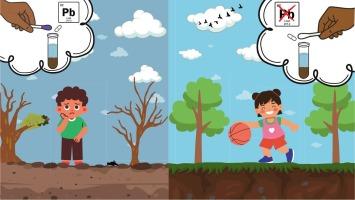A simple kit to detect extractable lead concentrations in soil
IF 6.6
1区 农林科学
Q1 SOIL SCIENCE
引用次数: 0
Abstract
Lead (Pb) contamination of soil is often spatially very heterogeneous and therefore difficult to map and remediate. To address the issue, we simplified a previously developed screening method that relies on an acidic glycine solution to extract Pb from soil using a 10:1 solution to soil ratio and the precipitation of purple Pb rhodizonate as a visual indicator to avoid filtration of the extract. The simplified kit consists of a plastic test tube, a soluble gel capsule of glycine hydrochloride crystals, a strip of pH paper, and a commercially available cotton swab impregnated with sodium rhodizonate designed for testing Pb-based paint. The swab turns purple at a concentration in the extract equivalent to a concentration of ∼200 mg/kg Pb in soil. The swab method was evaluated using 201 dried and sieved soil samples from the US and Peru spanning the 100–10,000 mg/kg range in total Pb concentrations. Excluding 14 samples from Peru with an extract pH > 3, the results show a sensitivity and selectivity of 85 % relative to an extractable Pb concentration of 200 mg/kg in the kit extract measured by X-ray fluorescence. The kit extracts about a third of the Pb released from soil using US EPA Method 1340. Depending on the proportion of extractable Pb in a specific soil sample, the kit could therefore help households and communities detect soil contamination from mining, smelting, battery recycling, or flaking paint down to 3 times the recently lowered US EPA screening level of 200 mg/kg for total Pb in soil.

一种检测土壤中可提取铅浓度的简易试剂盒
土壤铅污染通常在空间上是非常不均匀的,因此难以绘制和修复。为了解决这一问题,我们简化了先前开发的一种筛选方法,该方法依赖于酸性甘氨酸溶液从土壤中提取铅,使用10:1的溶液与土壤的比例,并将紫色红绿酸铅的沉淀作为视觉指标,以避免提取物的过滤。简化的试剂盒包括一个塑料试管,一个盐酸甘氨酸晶体的可溶性凝胶胶囊,一条pH值纸,和一个市售的浸渍了rhodizonate钠的棉签,用于测试基于铅的油漆。当提取液的浓度相当于土壤中200mg /kg的铅浓度时,棉签变成紫色。用来自美国和秘鲁的201个干燥和筛过的土壤样本对棉签法进行了评估,总铅浓度在100-10,000 mg/kg范围内。排除来自秘鲁的14个样品,提取液pH为>; 3,结果表明,相对于x射线荧光测定的试剂盒提取液中可提取的Pb浓度为200 mg/kg,灵敏度和选择性为85%。该试剂盒提取约三分之一的铅释放从土壤使用美国环保局方法1340。根据特定土壤样品中可提取铅的比例,该试剂盒可以帮助家庭和社区检测采矿,冶炼,电池回收或剥落油漆造成的土壤污染,降低到最近降低的美国环保署筛选水平200毫克/公斤土壤中总铅的3倍。
本文章由计算机程序翻译,如有差异,请以英文原文为准。
求助全文
约1分钟内获得全文
求助全文
来源期刊

Geoderma
农林科学-土壤科学
CiteScore
11.80
自引率
6.60%
发文量
597
审稿时长
58 days
期刊介绍:
Geoderma - the global journal of soil science - welcomes authors, readers and soil research from all parts of the world, encourages worldwide soil studies, and embraces all aspects of soil science and its associated pedagogy. The journal particularly welcomes interdisciplinary work focusing on dynamic soil processes and functions across space and time.
 求助内容:
求助内容: 应助结果提醒方式:
应助结果提醒方式:


